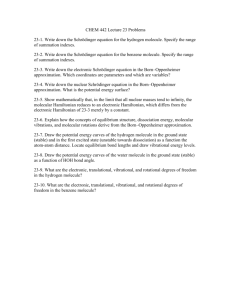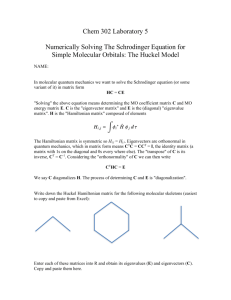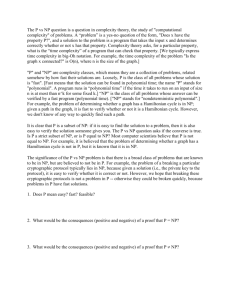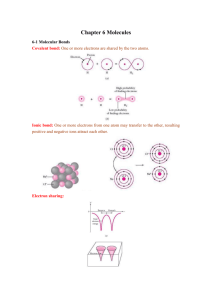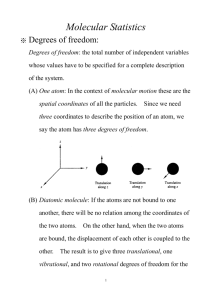Rotational motion methane molecules embedded
advertisement
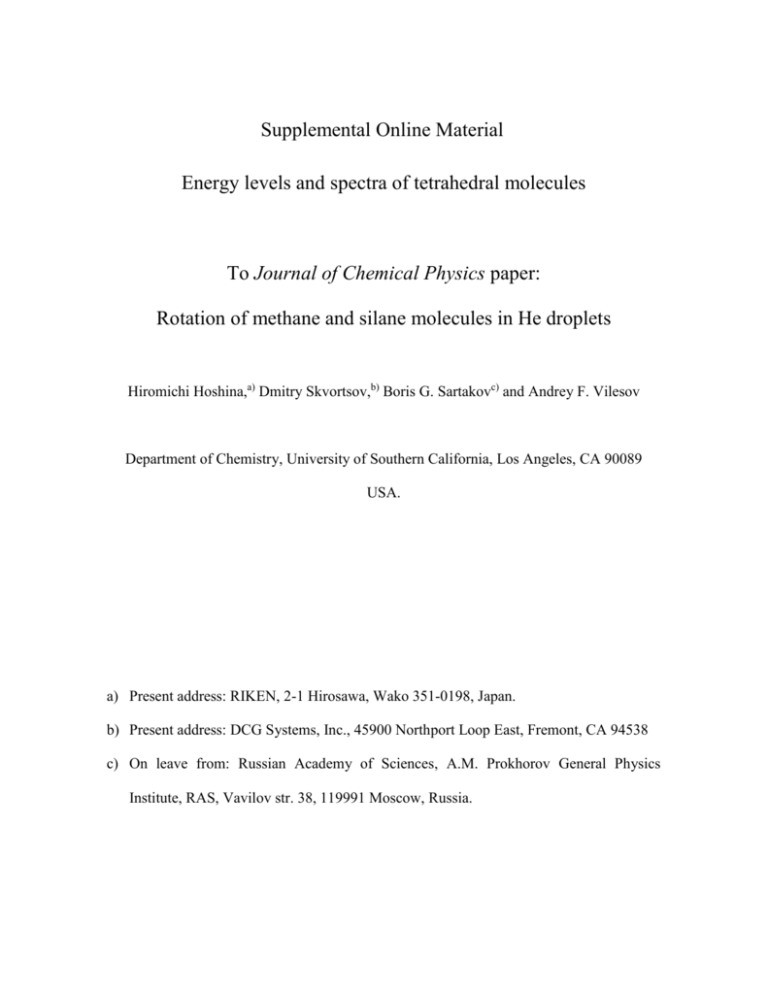
Supplemental Online Material Energy levels and spectra of tetrahedral molecules To Journal of Chemical Physics paper: Rotation of methane and silane molecules in He droplets Hiromichi Hoshina,a) Dmitry Skvortsov,b) Boris G. Sartakovc) and Andrey F. Vilesov Department of Chemistry, University of Southern California, Los Angeles, CA 90089 USA. a) Present address: RIKEN, 2-1 Hirosawa, Wako 351-0198, Japan. b) Present address: DCG Systems, Inc., 45900 Northport Loop East, Fremont, CA 94538 c) On leave from: Russian Academy of Sciences, A.M. Prokhorov General Physics Institute, RAS, Vavilov str. 38, 119991 Moscow, Russia. The rotational structure of vibrational bands of molecules embedded in 4He droplets was found to be similar to that in free molecules. However, the values of spectroscopic constants of embedded molecule differ from those in the gas phase. At present, the Hamiltonian for molecules surrounded by liquid helium cannot be derived from the first principles. Therefore, here we have used an effective rotational-vibrational Hamiltonian of free molecules for empirical fits of the infrared spectra of the embedded molecules. There are two main assumptions on the effective Hamiltonian which are usually used to account for the measured spectra of embedded molecules. First, is that the interaction between a molecule and superfluid helium environment does not change the symmetry of the effective Hamiltonian of the embedded molecule. Second, is that the effective Hamiltonian of a molecule in helium can be expanded into power series of vibration and rotation operators using the ordering scheme, which is similar to the Born-Oppenheimer scheme used for the Hamiltonian of free molecules. Here we consider the fundamental 3 mode of a methane-like molecule XY4 which has a tetrahedral symmetry. The vibration-rotation interaction between the 3 and other vibrational states will be neglected as in helium droplets only low rotational states of light molecules (J<3) are populated. In the framework of the Born-Oppenheimer scheme the effective Hamiltonian of a molecule can be expanded into power series of the angular momentum operators and the vibrational operators as:1 H ( 0 ) H 2, 0 H 0, 2 , H (1) H 2,1 , H ( 2 ) H 2 , 2 H 0, 4 , 2 H ( 3) H 2 , 3 , where H(i) is the i-th order part of the Hamiltonian and H n ,m terms collect all the power terms in which the total power of the vibrational operators is n and the total power of the rotational operators is m. This scheme was originally proposed and verified for the free CH4 molecules having rotational quantum numbers J10. In free molecules the order of magnitude of the terms can be estimated to be: H (0) ~ 1000 cm1 , H (1) ~ 1 cm1 , H ( 2) ~ 102 cm1 , H (3) ~ 105 cm1 . The effective Hamiltonian of molecule in helium usually shows slower convergence. Nevertheless, third order terms in the effective Hamiltonian are usually of about H (3) ~ 102 103 cm1 , which is sufficient for the fitting of the experimental spectra. The leading H n ,m terms are: H 2,0 3 p32 q32 / 2 3 3 1/ 2 is the harmonic oscillator Hamiltonian, H 0,2 B J 2 is the rigid rotor Hamiltonian, H 2,1 2 B 3 J l 3 is the Coriolis interaction term, where l is the angular 3 momentum operator of the 3 vibrational mode. 3 Hereafter we shall assume that the effective vibrational parameters, i.e. the frequency of the 3 mode and the Coriolis parameter 3 are not affected significantly by the interaction between the embedded molecule and the helium environment as the molecule-helium interaction is weak and does not change appreciably the force field of the molecule itself. Zero order and first order terms of the effective Hamiltonian are of spherical symmetry. The rotational spectrum of a molecule in the ground vibrational state in the first order of approximation is: E 0 B J ( J 1) where J is the angular momentum quantum number. The first order energy spectrum of the three fold degenerate vibration 3 state is complicated by the Coriolis interaction of the total angular momentum and the vibrational angular momentum of the 3 state (l3=1) and results in the splitting of each of the J rotational levels into three sublevels. These sublevels are commonly designated with the quantum number R which is the eigenvalue of the pure rotational angular momentum operator R J l 3 . The value of R runs from |J-l3| to J+l3 . Thus, each rotational state having J1 has three R sublevels J-1, J and J+1, which are also designated as F(-), F(0) and F(+) sublevels, respectively.2 In the first order and omitting zero point energy, energy levels in the ground and in the 3 states are given by the following equations: E ( 0, J , R J ) B J ( J 1) E ( 3 , J , R) 3 B J ( J 1) B 3 R( R 1) J ( J 1) 2 . Eigenfunctions of the first order Hamiltonian are obtained as a linear combination3 4 3 , l3 , J , M , R, K R C JR,,KK,l ,m J ,M ,K * ,l ,m . R 3 3 3 3 (1) K ,m Here J , M , K are symmetric top wavefunctions, where M and K are the quantum numbers of the projections of the total angular momentum on the space fixed axis and on the molecule fixed axis, respectively. degenerated harmonic oscillator. 3 ,l 3 , m3 are the wavefunctions of the triply In our case the vibrational quantum number 3 =1, and the vibrational angular momentum quantum number l3 =1; m3 is the quantum number of the projection of the vibrational angular momentum on the molecule fixed axis. Finally, CJR,,KK,Rl3 , m are the Clebsch-Gordan coefficients. In the ground vibrational state R=J and K R K . In the first order of approximation the eigenvalues of the ground state do not depend on K R and each R-sublevel is 2R+1 times degenerate. The power expansion of the dipole momentum operator over the vibrational coordinates in the molecule fixed system of coordinates reads as: 0 qi ... , qi i where 0 is the permanent dipole moment which equals zero in tetrahedral molecules. The term linear in qi yields nonzero matrix elements for the infrared active vibrational transitions i i 1 . The higher order nonlinear terms are successively diminishing in the magnitude in accordance with the Born-Oppenheimer ordering scheme. For the 3 mode the formula for the dipole moment operator can be written as: 2 d01 q3 , 5 where d 01 is the dipole moment matrix element of the fundamental transition of the vibrational mode and q3 is the dimensionless coordinate vector of the mode. The transformation from the molecule fixed system of coordinates to the space fixed system of coordinates yields the following expression for the space fixed components of the dipole moment D1,* ( , , ) (2) where D1,* ( , , ) is Wigner function, , , are Euler angles of the molecule orientation, are the spherical components of the dipole moment operator with respect to the space fixed system of coordinates, are the spherical components of the dipole moment operator with respect to the molecule fixed system of coordinates. According to Eq. (2) is a scalar product of the pure rotational function D1,* ( , , ) and the vibrational vector . Therefore, in the first order of approximation, the dipole moment matrix elements of must obey the selection rule of R=0 and the R-, Q- and Pbranches of the 3 band include only the rotational-vibrational transitions to/from F(-), F(0) and F(+) Coriolis sublevels, respectively, as shown in Fig. 2. The selection rule R=0 is sensitive to the perturbations which break the spherical symmetry of the first order Hamiltonian. Therefore, the absence of the rotational-vibrational transitions other than having R=0 can be considered as an evidence of the weakness of the high order terms in the effective Hamiltonian. The second and third order terms of the Hamiltonian of tetrahedral molecules have been analyzed in Refs.3-5 The centrifugal distortion part of the Hamiltonian reads as:3 6 H 0, 4 Ds J 4 Dt Oˆ JJJJ , where the first term is a scalar and does not break the spherical symmetry of the first order Hamiltonian. The second term is a tensor allowed by the tetrahedral symmetry of the molecule. The tensor term lifts the K R degeneracy and leads to the splitting of the R-manifold of levels into the tetrahedral sublevels . In the case of Td group the symmetry species span A1 , A2 , E, F1 , F2 symmetry species. The H 2 , 2 term of the effective Hamiltonian in the case of the 3 mode is expressed as: 3 H 2, 2 Y3 3 J 2 Z 3s Oˆ JJ 33 ( scalar ) Z 3t Oˆ JJ 33 (tensor ) , where only the last term is tensoral. The explicit formulas for operators Ô are given in Ref.3 Finally, the third order terms read as: H (3) F3s J 2 (J l 3 ) F3t Oˆ JJJ 3 . The tensoral Ô operators, which lead to the breaking of spherical symmetry in the 3 state, appear in the second and higher order terms of the Hamiltonian. In the case of fundamental 0 3 transition, these terms can be considered as a small perturbation with respect to the Coriolis splitting. Therefore, the manifold of the tetrahedral sublevels can be characterized by the good quantum numbers R. The matrix elements of the tensor operators of the third order Hamiltonian can be expressed using symmetry adopted Clebsch-Gordan coefficients F 4 (see Ref.4). The tetrahedral sublevels are labeled as k=p where is the symmetry of sublevel and p is the running index used to enumerate the eigenstates of the same symmetry within the manifold of levels J, R. In the studied molecules, the tensor terms are too weak to 7 significantly perturb the Coriolis sublevels. Therefore, the approximate selection rule k 0 determines the strong transitions in the 3 band. 4 Ten parameters 3 , B , 3 , Y3 , Z 3s , Z 3t , F3s , F3t , Ds and Dt appear in the third order Hamiltonian of tetrahedral molecules constants of the potential energy surface.3 and they can be expressed via the force The frequencies of the allowed R 0 vibrational-rotational transitions 0, J 3 , J ' (R = J) can be parameterized by six spectroscopic constants as: 6 PR ( J , k ) m nX pX 2 qX 3 g C( J ) ( 1) J FA(14kk, J' , J ) , A( X ) where X=J+1 and X=-J for the R- and P-branches, respectively. Q ( J , k ) m J ( J 1) 2 g (3) For the Q branch lines: C( J ) ( 1) J FA(14kk, J' , J ) , B( J ) (4) where A(X) 2X(2X 1) , B(X) 2X(2X 2) , C(X) [ (2X - 3)(2X 5)]1/2 . F4 coefficients have been tabulated elsewhere.4,5 Here we have neglected constant h,6 which makes negligible contribution to νP,R at J < 3. Hougen’s notation7,8 reads as: k pA1 k ' pA2 The selection rule k 0 in k pF1 k ' pF2 or or k pE k ' pE , see Fig. 2. Six spectroscopic constants m, n, p, q, , g can be expressed in terms of ten molecular constants of the effective Hamiltonian as follows: m 3 2 Beff 3 Z 3s / 2 , 8 n 2 Beff (1 3 ) Y3 (5 / 6) Z 3 s F3 s , p Y3 Z 3s / 3 2F3s , Y3 (2 / 3) Z 3s F3s , g 3 / 7 Z3t 10 Dt 4 F3t , q 4 Ds F3s . All ten molecular constants of the Hamiltonian can not be unambiguously obtained from the spectra of strong transitions due to the limitations implied by the selection rules k 0 and R=0 and usually require observation of additional weak R 0 and k 0 transitions. The dipole moment i 3 0, J , M , R J , k matrix element state and the final of transition between the initial f 3 1, J ' , M ' , R' , k ' state is J 'M ' f d i d fi d01 k 'k R'R CJM ,1 The spectral dependence of the absorption cross section of the transition f i is fi ( ) 4 2 d 2fi fi / c g fi ( fi ) , where fi is the frequency of the line and g ( fi ) is the normalized line form-factor. The acceptable fit of the observed spectra was reached with the Lorentzian form-factor g ( fi ) Lor 2 [( fi ) 2 Lor ] where Lor is an empirical broadening parameter. Finally the absorption spectra are simulated using the following expression: 9 2 S ( ) 4 2 d 01 3 / 3c Lor 2 J '1 NJ k 2 2 J 1 [( fi ) 2 Lor ] (5) where N J k is the total population of initial k=p symmetry sublevel of the J rotational level in the ground vibrational state. Upon derivation of the Eq. (5) we used the sum rule C J 'M ' 2 JM ,1 (2 J '1) / 3 . M ,M ' The integral intensity of a spectral line is determined by the factor: 2 J '1 N Jk . 2J 1 The value of N Jk is determined by the Boltzmann factor of rotational level J and by the nuclear spin weight of symmetry sublevel . At room temperatures the molecules populate high J states where the partition numbers of sublevels of symmetry are in ratio: A : A : E : F : F 1 : 1 : 2 : 3 : 3 1 2 1 2 Accordingly, the nuclear spin weights w ratio for XH4 is: wA1 : wA2 : wE : wF1 : wF2 5 : 5 : 2 : 3 : 3 , and the nuclear spin weights w ratio for XD4 is: wA1 : wA2 : wE : wF1 : wF2 15 : 15 : 12 : 18 : 18 Upon cooling to the ambient temperature in the helium droplet of 0.37 K the spin species remain unrelaxed during the flight from the pick-up chamber to the mass-spectrometer. On the other hand, the relaxation between rotational levels is fast enough to yield the equilibrium rotational-vibrational distributions of population for the A , E and F spin species. Therefore, because the energy spacing between rotational levels of XH4 and XD4 molecules is much larger than droplet’s temperature of 0.37 K, all the A1 and A2 spin species are in the J=0, = A1 state; E spin species are in the J=2, = E states and 10 all the F1 and F2 spin species are in the J=1, = F1 states. Thus the relative population of the rotational levels of XH4 in the droplets is: N J 0, A : N J 1, F : N J 2, E 5 : 9 : 2 The relative population or rotational levels of XD4 in the droplets is: N J 0, A : N J 1, F : N J 2, E 5 : 18 : 4 Therefore, because the symmetry of the tetrahedral molecule is preserved in helium droplets the ratio of the integral intensities of spectral lines for XH4 in helium droplets is expected to be: I P 2 : I P1 : I Q 2 : I Q1 : I R 0 : I R1 : I R 2 12 : 30 : 20 : 90 : 150 : 150 : 28 and for XD4 to be: I P 2 : I P1 : I Q 2 : I Q1 : I R 0 : I R1 : I R 2 12 : 30 : 20 : 90 : 75 : 150 : 28 . Literature 1. 2. M. R. Aliev and J. K. G. Watson, J. Mol. Spectrosc. 61, 29-52 (1976). G. Herzberg, Molecular spectra and molecular structure, II Infrared and Raman spectra of polyatomic molecules. (Van Nostrand, Princeton, New Jersey, London, 1968). 3. 4. 5. 6. 7. K. T. Hecht, J. Mol. Spectrosc. 5, 355-389 (1961). J. Moret-Bailly, L. Gautier, and J. Montagutelli, J. Mol. Spectrosc. 15, 355-377 (1965). B. J. Krohn, Los-Alamos Scientific Report LA-6554 MS (1976). B. Bobin and K. Fox, Journal De Physique 34, 571-582 (1973). J. T. Hougen, MTP International Review if Science, Physicsl Chemistry Series Two, Vol. 3 (Spectroscopy), Edited by D.A. Ramsay (Butterworths). (1976). 11 8. J. T. Hougen, J. Chem. Phys. 39, 358-365 (1963). 12
